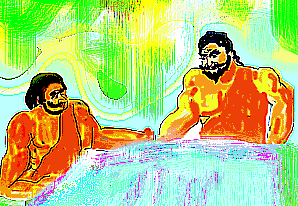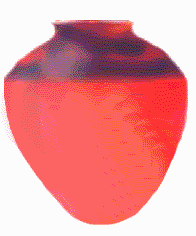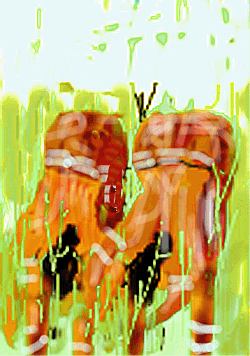Megaliths of Hyderabad
Large numbers of granite tombs found all over Hyderabad, ascribed to prehistory.... All over Hyderabad and surounding areas there are prehistoric monuments ascribed to the megalithic peoples. They were skilled in handling large granite slabs mainly found in their tombs. The stone tombs are usually 3 metres underground and are marked on the surface by a circle of large rounded boulders. In Hyderabad area they are dated variously from 300 BC to 400 AD by archeologists, who say similar constructions in the sandstone area to the south date from 1300 BC.
All over Hyderabad and surounding areas there are prehistoric monuments ascribed to the megalithic peoples. They were skilled in handling large granite slabs mainly found in their tombs. The stone tombs are usually 3 metres underground and are marked on the surface by a circle of large rounded boulders. In Hyderabad area they are dated variously from 300 BC to 400 AD by archeologists, who say similar constructions in the sandstone area to the south date from 1300 BC.
news : Recently megaliths of iron age dated to 2000 BC have been found at Almora, UP.
There may be a link, not clear yet, to very similar monuments found all the way from Ireland, England, Scandinavia, Germany, Malta, Palestine, Iran, South Russia -Caucasus, and Baluchistan, and South East Asia.
In Hyderabad they are found in ASRao Nagar area, Hashmatpet and Gachibowli. The one in Hashmatpet can be examined by visitors. Recently one more was excavated at Univ of Hyd, too. They were found in other areas too but the city has covered them over. The sheer numbers of these megalith tombs tell us the population of prehistoric Hyderabad-Secunderabad was quite large, possibly in tens of thousands.
Who were these people and what did they do for a living? Why did they have stone tombs?
It appears they had some notion of after life : the person who passed away needed not only a nice place to stay, preferably in stone, but also needed foodstuff in pots, earthen lamps, his/her favourite tools or implements besides beads and jewellery.
So they dug a large hole in the ground overlooking lakes, placed large flat slabs of granite in a box shape to form a tomb. The person was laid to rest, (or the ashes after cremation) with the grave goods arranged inside the cell. Then the whole thing was covered over with earth and stones, making a circular mound marked with boulder circles.
 Periodically the place would be cleaned up. It is possible these large tombs each belonged to a particular 'family" or clan and were regularly used for centuries. Many megaliths have a port hole on one upright slab, possibly for placing oil lamps, incense, offerings to the ancestors. These would be during grave social crises , or important occasions and for thanksgiving (for example it appears many megaliths were opened up and counterstruck coins of satavahanas ( commemorating defeat of Sakas) were placed in them. In some areas Roman coins of Tiberius were also found. The dating by carbon-14 is flawed since tree roots go right into the graves and termites thoroughly mix up surface organic material with the ones below the surface.
Periodically the place would be cleaned up. It is possible these large tombs each belonged to a particular 'family" or clan and were regularly used for centuries. Many megaliths have a port hole on one upright slab, possibly for placing oil lamps, incense, offerings to the ancestors. These would be during grave social crises , or important occasions and for thanksgiving (for example it appears many megaliths were opened up and counterstruck coins of satavahanas ( commemorating defeat of Sakas) were placed in them. In some areas Roman coins of Tiberius were also found. The dating by carbon-14 is flawed since tree roots go right into the graves and termites thoroughly mix up surface organic material with the ones below the surface.
Construction workers and earth diggers (waddar community) are quite familiar with these tombs... they have dug up several while making foundations for houses, they told me. Mostly large pots of cremated ashes, they said.
 What else is found?
What else is found?
Even where burials were intact, few bones are found now due to passage of centuries: but very rusted IRON ploughs, tridents ( trisulas), arrowheads, swords, horse mouth bits and stirrups are often found. ( they rode horses, and were experts in iron and steelmaking). Very rarely a spiral gold earring. There are also metal utensils like long handled ladles, cups, tripods for pots, etc, and long "celts" or crowbars --locally today called gadda paara and still used for breaking up rocks and stones and digging the soil. (By the way the items found in these monuments are considered to bring very bad luck and generally handed over to authorities). The wheel turned pottery is extremely well made--and characteristically reddish with a black top. Some of them have a shine/polish intact too. The pots are pretty large, presumably grain was stored in them. The ones I saw looked very well designed, almost modern and I am sure they could be sold in crafts villages even today. (According to ceramic experts good quality pottery is very difficult to make, let alone mass produce.)
 There's no inscription or writing anywhere , although some scribblings like potter's marking has been found on such pottery elsewhere. The megalith people are responsible for Husain Sagar and all other such lakes of the Eastern Deccan. Sounds far fetched? No. They were the first to undertake massive civil engineering in a cooperative way: they expertly identified the places , where a rivulet could be dammed by a low stone/earth dam. This would create a lake: ensuring water supply even in driest summer, besides making it possible to raise a second crop of rice. ----- they also introduced rice for the first time in South India. ( Earlier , the stone using neolithic people here used to prefer ragi (eleusine corcana) , and bajra - millets, panicum ).
There's no inscription or writing anywhere , although some scribblings like potter's marking has been found on such pottery elsewhere. The megalith people are responsible for Husain Sagar and all other such lakes of the Eastern Deccan. Sounds far fetched? No. They were the first to undertake massive civil engineering in a cooperative way: they expertly identified the places , where a rivulet could be dammed by a low stone/earth dam. This would create a lake: ensuring water supply even in driest summer, besides making it possible to raise a second crop of rice. ----- they also introduced rice for the first time in South India. ( Earlier , the stone using neolithic people here used to prefer ragi (eleusine corcana) , and bajra - millets, panicum ).
What language did they speak? We are not sure what language the megalithic Hyderabad people spoke: possibly it was some form of early prakrit ---most people hereabouts during the following satavahana times spoke Prakrit (common man's sanskrit) , and possibly Desi, an ancestor of Telugu. Some of the designs of megalithic times are identical to "muggu" rangoli made in villages on door steps- hearths. They could be some sort of proto saivites because the grave goods give some indication.
The megalith people are known for their heavy bones ( well they used to heave huge rock slabs, so they must have been very strongly built anyway). We do not know how they looked like, except that they had very thick bones and were well muscled (girls also), and mostly had big teeth. We don't know anything about their complexion, pink or wheat or brown or blueblack --whatever. Early researchers used to call them scythian, old saka, scytho dravidian or a form of "protoaustraloid" which doesnt really mean anything.
CCMB (Director Dr. Lalji Singh ) and other organisations are going to collect and analyse the dna from the old bone remains shortly. Then probably we could figure out who they were related to, among today's people. In the meantime, know any andhra/ kannada /marathi community with thick bones and skulls and muscles and big toothy smiles? (three communities sometimes claim tthe megaliths belonged to their ancestors---reddis, maalas and waddars. lets see.)
some more varied speculation depending on the bias Serg Valganov has tons of snaps on Black Sea -Caucasus megaliths
back to index of cultural aspects of hyderabad area
© text and graphics by v ramchandra rao
email : vramrao@yahoo
 All over Hyderabad and surounding areas there are prehistoric monuments ascribed to the megalithic peoples. They were skilled in handling large granite slabs mainly found in their tombs. The stone tombs are usually 3 metres underground and are marked on the surface by a circle of large rounded boulders. In Hyderabad area they are dated variously from 300 BC to 400 AD by archeologists, who say similar constructions in the sandstone area to the south date from 1300 BC.
All over Hyderabad and surounding areas there are prehistoric monuments ascribed to the megalithic peoples. They were skilled in handling large granite slabs mainly found in their tombs. The stone tombs are usually 3 metres underground and are marked on the surface by a circle of large rounded boulders. In Hyderabad area they are dated variously from 300 BC to 400 AD by archeologists, who say similar constructions in the sandstone area to the south date from 1300 BC.  Periodically the place would be cleaned up. It is possible these large tombs each belonged to a particular 'family" or clan and were regularly used for centuries. Many megaliths have a port hole on one upright slab, possibly for placing oil lamps, incense, offerings to the ancestors. These would be during grave social crises , or important occasions and for thanksgiving (for example it appears many megaliths were opened up and counterstruck coins of satavahanas ( commemorating defeat of Sakas) were placed in them. In some areas Roman coins of Tiberius were also found. The dating by carbon-14 is flawed since tree roots go right into the graves and termites thoroughly mix up surface organic material with the ones below the surface.
Periodically the place would be cleaned up. It is possible these large tombs each belonged to a particular 'family" or clan and were regularly used for centuries. Many megaliths have a port hole on one upright slab, possibly for placing oil lamps, incense, offerings to the ancestors. These would be during grave social crises , or important occasions and for thanksgiving (for example it appears many megaliths were opened up and counterstruck coins of satavahanas ( commemorating defeat of Sakas) were placed in them. In some areas Roman coins of Tiberius were also found. The dating by carbon-14 is flawed since tree roots go right into the graves and termites thoroughly mix up surface organic material with the ones below the surface.  What else is found?
What else is found?  There's no inscription or writing anywhere , although some scribblings like potter's marking has been found on such pottery elsewhere. The megalith people are responsible for Husain Sagar and all other such lakes of the Eastern Deccan. Sounds far fetched? No. They were the first to undertake massive civil engineering in a cooperative way: they expertly identified the places , where a rivulet could be dammed by a low stone/earth dam. This would create a lake: ensuring water supply even in driest summer, besides making it possible to raise a second crop of rice. ----- they also introduced rice for the first time in South India. ( Earlier , the stone using neolithic people here used to prefer ragi (eleusine corcana) , and bajra - millets, panicum ).
There's no inscription or writing anywhere , although some scribblings like potter's marking has been found on such pottery elsewhere. The megalith people are responsible for Husain Sagar and all other such lakes of the Eastern Deccan. Sounds far fetched? No. They were the first to undertake massive civil engineering in a cooperative way: they expertly identified the places , where a rivulet could be dammed by a low stone/earth dam. This would create a lake: ensuring water supply even in driest summer, besides making it possible to raise a second crop of rice. ----- they also introduced rice for the first time in South India. ( Earlier , the stone using neolithic people here used to prefer ragi (eleusine corcana) , and bajra - millets, panicum ).